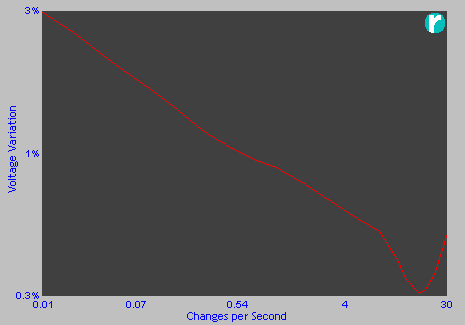|
The only real problem behind flicker is the change in brilliance of a lamp or lighting. The effect is psychological, although one must not underestimate the effect! It's been rated such a problem that a bunch of guys got together and created a set of "rules" as to what defines the intensity of flicker. This standard, IEC-868 (there are now derivatives too), is based on a series of calculations to arrive at the two results of Pst and Plt (Perception of flicker short term, and long term respectively). To start understanding flicker we need to understand the basic of what is the rudimentary basics of flicker. Flicker itself is nothing more than the amplitude modulation of the incoming supply, with amplitude modulation being a change in level. The complexity of flicker is the fact that infrequent changes are less of an issue than the frequent ones with severity increasing the faster the modulation.
Although flicker usually results in only psychological stress, it cannot be ignored when the modulation starts to come close to 8.8Hz as this could affect those who are prone to epilepsy. It sounds almost impossible to have happen, but think of a motor speed controller spinning a 4-pole motor at 1236 revs/min instead of 1500. The current drawn on the supply would closely represent 41.2Hz while the supply is 50Hz. A difference of, you guessed it, 8.8Hz. But such modulations are not only restricted to devices such as motor controllers. Generation plants are just as prone to causing flicker, especially if more "green" ones such as "wind farms". Wind turbines suffer an effect called "tower shadow" which occurs as a blade passes the tower. It is, for a brief moment, starved of the wind that turns it. Take a farm of 9 turbines each spinning at 1 rev per 3 seconds making the average blade passing a tower every 1 second. Now all it needs is for each turbine to be at just the right point and 9Hz modulation will become evident. Although we have taunted the wind farm installation companies, diesel generators are also capable of producing flicker when speed governors are not tuned properly. Determining flicker is done as follows:
© 05.05.02 |
 INTERPRETING THE READINGS:
INTERPRETING THE READINGS: